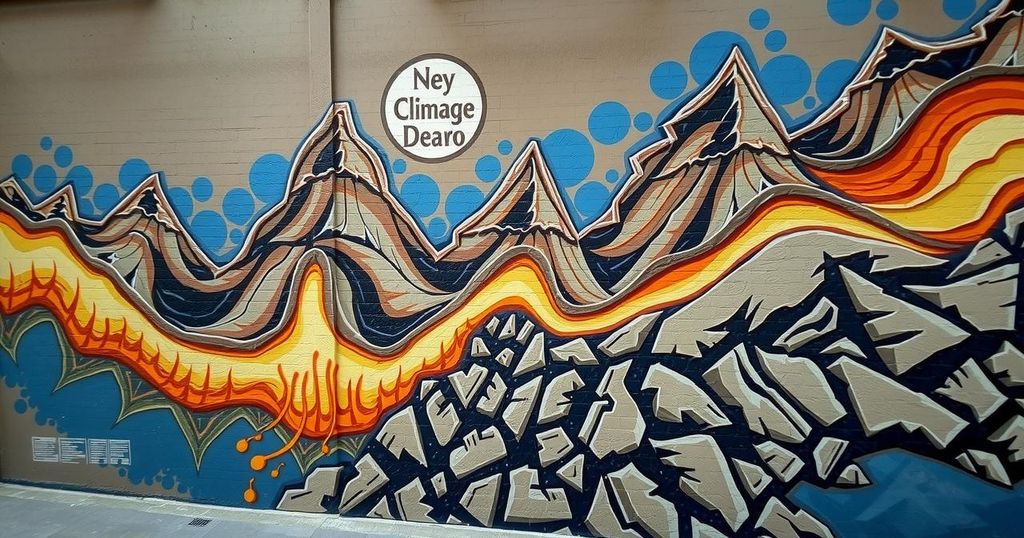Mundano’s Mural in Sao Paulo: A Call to Action Against Climate Disasters

Brazilian artist Mundano has unveiled a significant mural in Sao Paulo utilizing materials such as ash from wildfires and mud from floods. The work addresses severe climate issues in Brazil, including deforestation and extreme weather, highlighting the urgent need for action from corporate entities like Cargill. The mural features Indigenous activist Alessandra Korap and intends to foster accountability regarding environmental destruction.
On Wednesday, Brazilian artist Mundano unveiled a monumental mural in Sao Paulo, crafted from ash derived from wildfires and mud sourced from flood-affected regions. This artwork serves as a poignant commentary on the climate crises impacting Brazil, particularly focusing on the alarming weather events that have wreaked havoc throughout the nation. Spanning over 30 meters (98.4 feet) in height and 48 meters (157.5 feet) in width, the mural vividly illustrates the consequences of deforestation and drought within the Amazon rainforest, presenting barren earth and gray tree stumps. It prominently features Indigenous activist Alessandra Korap, adorned with a crown of flowers and holding a placard urging, “Stop the destruction keepyourpromise.” This message is directed towards Cargill, a Minnesota-based soy corporation identified as a significant contributor to Amazon deforestation, with which Mundano seeks accountability. Mundano articulated the frustration felt by many, stating, “We are tired of being a country, a continent where we and the natural resources we have here are exploited. … We have to regenerate our planet instead of destroying it.” The recent surge in destruction has been exacerbated by human-induced wildfires across various eco-sensitive areas including the Amazon and the Pantanal, which have released extensive smoke, adversely impacting air quality in several cities. Furthermore, a critical drought persists, adversely affecting Brazil, with projections indicating its continuation for at least the remainder of the month, as reported by Cemaden, the nation’s disaster warning body. The depth of the Amazon’s Negro River dropped to unprecedented lows this year, highlighting the severity of the drought when compared with historical data. Earlier flooding in Rio Grande do Sul resulted in significant loss of life and displacement of communities, further emphasizing the interconnected nature of these climate phenomena. Mundano, who identifies himself as an “artivist,” incorporated mud from the devastating floods, ash from the Amazon, the Atlantic Forest, the Pantanal, and the Cerrado, as well as earth scavenged from outdoor dumpsters in Sao Paulo and clay collected from the Sawre Muybu Indigenous land. As the artist commented in his Instagram post, “From floods to droughts, everything is connected!” This mural marks Mundano’s largest project to date, continuing his earlier work from three years prior, which also utilized ash from the Amazon to raise awareness about deforestation and its consequences.
The mural created by Mundano in Sao Paulo addresses the pressing issue of climate change, particularly its manifestation in Brazil through droughts, floods, and deforestation. The Amazon rainforest, a critical global ecosystem, is facing severe threats from human activities such as agriculture, particularly soy farming, which contributes to rampant deforestation. Cargill has pledged to eliminate deforestation from its supply chain by 2025, but skepticism remains regarding the enforcement of such promises. This mural not only serves as an artistic expression but also as a vital advocacy tool aimed at raising awareness and promoting accountability among corporations and the public alike.
In summary, Mundano’s mural in Sao Paulo serves as a striking visual representation of the climate emergencies affecting Brazil, particularly the devastating impacts of deforestation and extreme weather such as floods and droughts. It underscores the urgent need for corporate accountability in environmental stewardship, particularly from companies like Cargill that have significant influence over land use practices in the Amazon. Through creative activism, Mundano invites viewers to understand the interconnectedness of these environmental crises and challenges them to advocate for a sustainable future.
Original Source: abcnews.go.com





